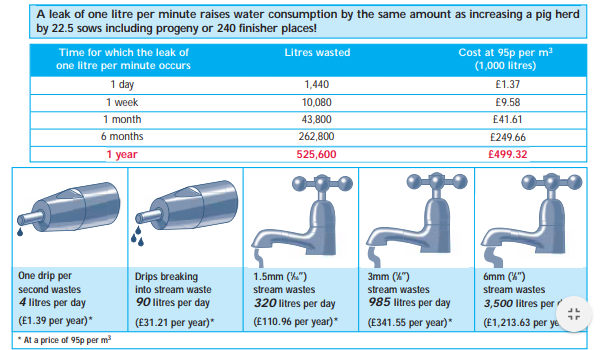- Home
- Knowledge library
- Water usage on pig farms
Water usage on pig farms
Water is a finite resource with a cost to the business. Find out how to monitor this precious resource for improved efficiency and cost control.
Regularly check:
- Water meters – detecting unexpected increases in water consumption helps to detect leaks quickly
- Water supply – water from boreholes and private supplies are as important as that from mains supplies
- Quality of source – check for problems, including increased sediment or periods of poor flow. Contingency plans, such as alternative supplies, must be available in case the original source fails
Resource efficiency
Tools are available to help you evaluate how efficiently you are using water on farm and to highlight ways to save costs and maximise water efficiency.
LEAF’s Simply Sustainable Water booklets can help you to develop an effective on-farm management strategy for efficient water use and to improve the farm’s contribution to protecting water in the environment. They enable you to get the best from this valuable resource, to improve awareness of the importance of water and track changes in water use and quality over time.
Leaks and breaks
A leak of 1 l/min raises water consumption by the same amount as increasing a pig herd by 22.5 sows (including progeny), or 240 finisher places. A drinker leaking at 90 drips per minute will waste around 29 litres of water per day. Not only are leaks expensive, they also add to slurry volume.
You can reduce wastage by checking, maintaining and repairing leaking drinkers, pipework and fittings promptly. Ensure outdoor pipes are protected against pig or machinery damage (for example, using physical shielding).
Before winter, drain down and close off all pipe lengths not in use and ensure that water is kept moving in pipes that are in use. This will help prevent pipes from freezing, bursting and overflowing. Insulate exposed pipework and fittings; burying pipes is often impractical. Insulation prevents water from getting too hot in summer as well as from freezing in winter. Pipes with larger diameters are less likely to freeze than pipes with smaller diameters.
Drinkers
Use drinkers of the appropriate size for the age of the pig. Ensure they are set up correctly for high- or low-pressure systems.
- Cup or bowl drinkers waste less water through spillage
- Mount water nipples correctly to reduce the amount of water wasted
- Set nipples for the height of the smallest pig in the pen
- Ensure adjustable heights if the size of pig changes during the stocking period (for example, in wean-to-finish facilities)
- Providing a step for smaller pigs can reduce water waste by 13% and the volume of manure by 10% compared to conventional nipple drinkers
- When bite nipples are pointed straight out, pigs should drink from shoulder height. When mounted at a 45º angle, the nipple should be 5 cm (2 inches) above the back of the pig. Mounting lower than this will increase water wastage

Diet and wet/dry feeders
Feeding a diet containing excessive protein and/or excessive mineral levels results in increased water usage.
Wet/dry feeders used in grower/finisher accommodation reduce water use by 34% and slurry volume by 20–40% compared with dry feeders and a bowl. Wet/dry feeders also increase consumption of mash diets compared with dry feeders and a separate water nipple, resulting in a 5% improvement in average daily gain.
Pressure washing
- Train users to wash methodically
- Removing solid waste and pre-soaking before washing down will reduce the amount of water needed
- Degreasers and detergents will improve washing efficiency
- Using hot water can decrease washing time and the amount of water used
- Handwashing with brushes and sponges may be more appropriate for some tasks, for example, around controllers or behind feeders.
- Ensure all washing equipment has trigger controls to stop the flow when not required (adjustable and turbo nozzles improve efficiency)
- When refurbishing or replacing buildings and equipment, consider the benefits of easily cleaned, smooth surfaces over rough or porous materials
Heat, droughts and flooding
Over the last few years, the UK has experienced periods of heat, drought and flooding, which can cause water shortages and increase the cost of water.
Heat
Pigs’ water requirement increases in hot weather. Buildings must have correct ventilation to make sure that pigs do not become too hot and to prevent water from being used for cooling. If water spray cooling systems are required, they should be controlled automatically, not manually.
Drought and hosepipe bans
In England, during periods of low rainfall, temporary water use restrictions for domestic customers may be put in place. In pig farming, water use is not normally affected – especially where health and welfare or safety is concerned. However, producers must check with their supplier the exceptions that apply to them because rules and exceptions vary.
Flooding and wet weather
To find out the likelihood of flooding and current warnings in their area, producers can use:
- The Environment Agency's flood map
- The flood information service website (updated every 15 minutes)
- The 24-hour Floodline service: 0345 988 1188
- Floodline Warnings Direct, a free service that provides direct flood warnings by telephone, mobile, fax or pager. It also provides practical advice on preparing for a flood and what to do if one occurs
Guidance on managing manure after long periods of wet weather

